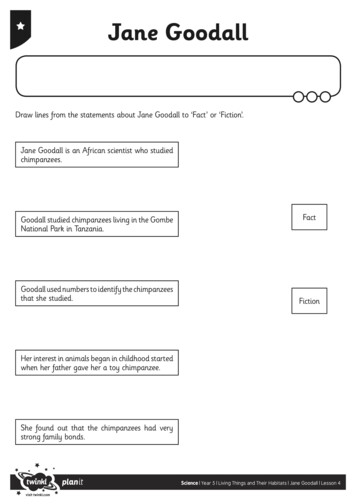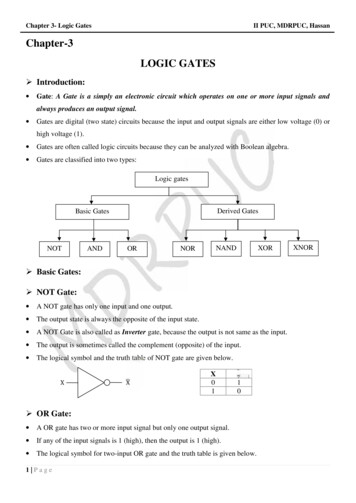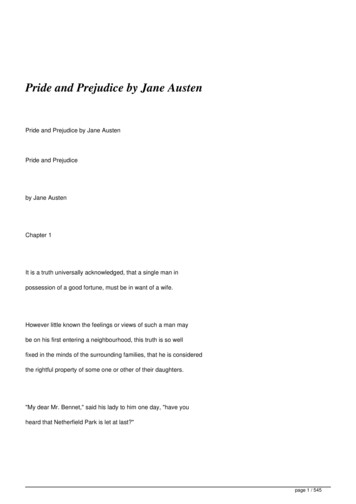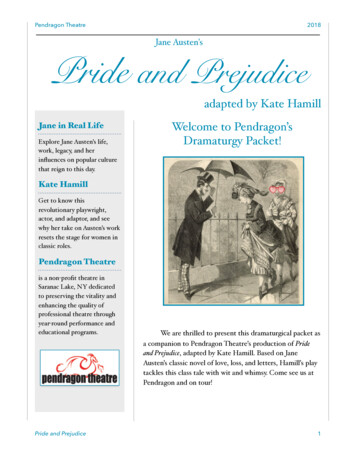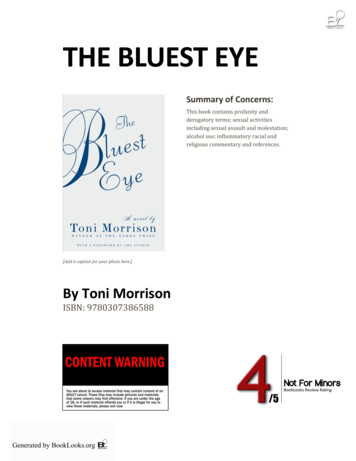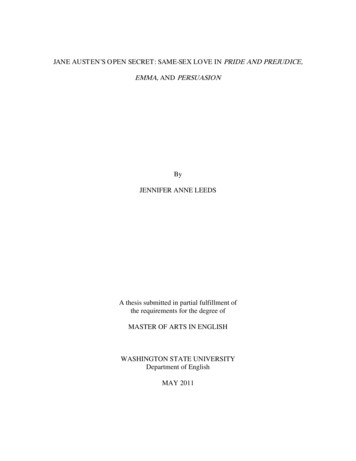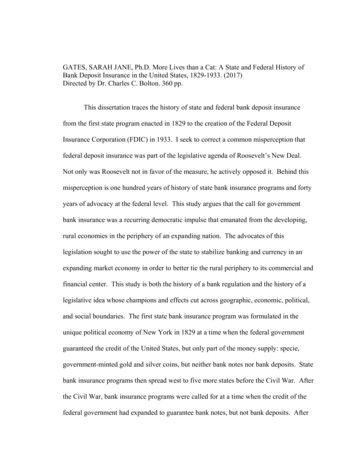
Transcription
GATES, SARAH JANE, Ph.D. More Lives than a Cat: A State and Federal History ofBank Deposit Insurance in the United States, 1829-1933. (2017)Directed by Dr. Charles C. Bolton. 360 pp.This dissertation traces the history of state and federal bank deposit insurancefrom the first state program enacted in 1829 to the creation of the Federal DepositInsurance Corporation (FDIC) in 1933. I seek to correct a common misperception thatfederal deposit insurance was part of the legislative agenda of Roosevelt’s New Deal.Not only was Roosevelt not in favor of the measure, he actively opposed it. Behind thismisperception is one hundred years of history of state bank insurance programs and fortyyears of advocacy at the federal level. This study argues that the call for governmentbank insurance was a recurring democratic impulse that emanated from the developing,rural economies in the periphery of an expanding nation. The advocates of thislegislation sought to use the power of the state to stabilize banking and currency in anexpanding market economy in order to better tie the rural periphery to its commercial andfinancial center. This study is both the history of a bank regulation and the history of alegislative idea whose champions and effects cut across geographic, economic, political,and social boundaries. The first state bank insurance program was formulated in theunique political economy of New York in 1829 at a time when the federal governmentguaranteed the credit of the United States, but only part of the money supply: specie,government-minted gold and silver coins, but neither bank notes nor bank deposits. Statebank insurance programs then spread west to five more states before the Civil War. Afterthe Civil War, bank insurance programs were called for at a time when the credit of thefederal government had expanded to guarantee bank notes, but not bank deposits. After
the Panic of 1907, eight more states enacted deposit insurance programs. The call fordeposit insurance at the federal level began in 1886. The legislative idea was handeddown through one hundred and fifty bills and three generations of progressive Democratsfrom the Middle West and South before FDIC was created in 1933. Governmentmanaged bank insurance represented a renegotiation of the balance of power between thestate and private banks to use the power of the state to distribute default risk across allbanks, from the weakest to the most powerful. An underlying institutional argument ofthis study shows that state power was a precondition of government bank insurance andhow the state’s credit ultimately became the source of the guaranty. The federal guarantyof bank deposits was not cut from whole cloth in 1933; it was a recurring democraticimpulse from the periphery of American capitalism that can be traced to the beginning ofthe Republic.
MORE LIVES THAN A CAT: A STATE AND FEDERAL HISTORY OF BANKDEPOSIT INSURANCE IN THE UNITED STATES, 1829-1933bySarah Jane GatesA Dissertation Submitted tothe Faculty of The Graduate School atThe University of North Carolina at Greensboroin Partial Fulfillmentof the Requirements for the DegreeDoctor of PhilosophyGreensboro2017Approved byCharles C. BoltonCommittee Chair
To Jim, whose support for this project never wavered.ii
APPROVAL PAGEThis dissertation, written by Sarah Jane Gates, has been approved by thefollowing committee of the Faculty of The Graduate School at The University of NorthCarolina at Greensboro.Committee ChairCommittee MembersCharles C. BoltonGreg O’BrienMark ElliottJeffrey W. JonesOctober 20, 2017Date of Acceptance by CommitteeOctober 20, 2017Date of Final Oral Examinationiii
TABLE OF CONTENTSPageLIST OF TABLES . viCHAPTERI. INTRODUCTION .1II. JOSHUA FORMAN, MARTIN VAN BUREN, AND THE ROLE OFTHE STATE IN THE CONQUEST, SETTLEMENT, ANDECONOMIC DEVELOPMENT OF WESTERN NEW YORKDURING THE EARLY FEDERAL PERIOD, 1787-1828 .21Head of the Dog: The Role of the State in the Conquest andSettlement of Western New York, 1787-1806 .24The Erie Canal: The Role of the State in the EconomicDevelopment of Western New York, 1807-1828 .42III. MARTIN VAN BUREN, JOSHUA FORMAN, THE NEW YORKSAFETY FUND, AND THE SPREAD OF STATE BANKINSURANCE WEST ALONG THE AMERICAN FRONTIER,1829-1866 .61Banking, Bank Panics, and Bank Regulation in the Early FederalPeriod.65Rise of the Democratic Party and the Creation of the Safety Fund .76Expansion of Bank Insurance Programs West .98IV. THE EXPANSION AND DENIAL OF FEDERAL GUARANTYOBLIGATIONS DURING THE NATIONAL BANKING ERA,1863-1913 .105Federal Guaranty Supplied: The Circulating Medium, 1863-1865 .107Federal Guaranty Denied: The Failure of the Freedmen’s Savingsand Trust Company, 1874 .119Federal Guaranty Supplied: The U.S. Postal Savings System, 1910 .138iv
V. ROBERT L. OWEN, THE OKLAHOMA DEPOSIT INSURANCELAW, AND THE SPREAD OF STATE DEPOSIT INSURANCE INTHE AMERICAN FRONTIER, 1907-1929 .157Robert L. Owen, Jr. .166The Oklahoma Program .174The Spread of State Deposit Insurance Programs.181VI. WILLIAM JENNINGS BRYAN, ROBERT L. OWEN, AND THERISE OF FEDERAL ADVOCACY FOR DEPOSIT INSURANCEFROM THE MIDDLE WEST, 1886-1919.221Legislative Phase I, 1886-1906 .229Legislative Phase II, 1907-1919 .244VII. HENRY B. STEAGALL, FEDERAL DEPOSIT INSURANCE, ANDTHE “MID-CONTINENT REVOLUTION,” 1920-1933 .274Legislative Phase III, 1920-1933 .274VIII. CONCLUSION .327IX. EPILOGUE .335Acknowledgments.337BIBILOGRAPHY .343v
LIST OF TABLESPageTable 1. The Growth of State and National Banks and Bank Deposits inOklahoma, Kansas, Texas, and Nebraska, 1908-1913 .212Table 2. Legislative Phase 1: Federal Deposit Insurance Bills by Decade &Political Party, 1886-1906.230Table 3. Legislative Phase 1: Federal Deposit Insurance Bills by Decade &Region, 1886-1906 .231Table 4. Five-Year Subscribers to William Jennings Bryan’s The Commoner, asof Dec. 1907 .243Table 5. Legislative Phase II: Federal Deposit Insurance Bills by HistoricalContext and Party, 1907-1919 .247Table 6. Legislative Phase II: Federal Deposit Insurance Bills by HistoricalContext & Region, 1907-1919 .249Table 7. Legislative Phase II: Federal Deposit Insurance Bills by HistoricalContext and by States with Deposit Insurance Programs, 1907-1919 .256Table 8. Legislative Phase III: Fed. Dep. Ins. Bills by Historical Context &Political Party, 1920-1933.277Table 9. Legislative Phase III: Fed. Dep. Ins. Bills by Historical Context &Region, 1920-1933 .278Table 10. Federal Deposit Insurance Bills: Source of the Guaranty and Sources ofFunding by Legislative Phase, 1886-1933 .292vi
1CHAPTER IINTRODUCTIONThe Federal Deposit Insurance Corporation (FDIC) is commonly known as alegacy of the New Deal. Even the gift shop of the Franklin Delano RooseveltPresidential Library sells t-shirts printed with the FDIC logo along with the alphabet soupof New Deal program acronyms. Above and below the sea of acronyms is a quote fromhistorian Arthur Schlesinger, Jr.: “The world we live in today is Franklin Roosevelt’sworld.”1 Roosevelt may have signed the Banking Act of 1933, which created the FDIC,but he did not support the measure. In fact, he ardently worked to defeat it. AlthoughFDIC is commonly thought of as part and parcel of FDR’s legislative agenda, theprovision was enacted in an eleventh-hour political compromise. Only as the clock wasticking during the last days Congress was in session did Roosevelt agree to a carefullyconditioned deposit insurance provision in order to pass the bank reform that was on hisagenda, the separation of commercial and investment banking. It was Henry Steagall, theChairman of the House Committee on Banking and Currency from rural Alabama, whowagged the dog. With the support of key Congressional leaders from the Middle West,South, and West and increasing public pressure from the unabated financial crisis,1Arthur Schlesinger, Jr., “Franklin Delano Roosevelt” in “100 Leaders and Revolutionaries of theTwentieth Century,” Time, April 13, 1998.
2Steagall defended the deposit insurance provision in conference committee untilRoosevelt agreed to sign the bill into law.2Historical biographies of Roosevelt report his opposition to government depositinsurance in 1933 and earlier, but they also acknowledge that the FDIC came to beregarded by the public as “one of the New Deal reforms.” The president did nothing tocorrect that misperception and happily “reaped political credit for it.”3 Thismisperception is often repeated in broader histories of the New Deal. In Liberalism andits Discontents, for example, Alan Brinkley makes the common error of conflating thecreation of FDIC with Roosevelt’s other legislative efforts:Roosevelt did act effectively to stem the dangerous banking crisis. He declared a‘bank holiday,’ passed emergency bank legislation and later won passage of moresubstantial banking reforms that created federal insurance of banking deposits andstrengthened the Federal Reserve System.In Freedom from Fear, David Kennedy notes in one chapter that the Banking Act of 1933passed “over Roosevelt’s objections.” In another he proclaims, “The New Deal haddecisively halted the banking panic. The many millions whose bank savings had beensecured by the Federal Deposit Insurance Corporation owed a weighty political debt toFranklin Roosevelt.”4 These characterizations obscure the fundamental character of the2“Conferees Agree on Banking Bill,” New York Times, June 13, 1933, 1; Frank Freidel, Franklin D.Roosevelt: Launching the New Deal (Boston: Little, Brown and Company, 1973), 442-3; WilliamLeuchtenburg, Franklin D. Roosevelt and the New Deal, 1932-1940 (New York: Harper & Row, 1963), 60;Susan Kennedy, The Banking Crisis of 1933 (Lexington: University Press of Kentucky, 1973), 214-23.3Frank Freidel, Franklin D. Roosevelt: Launching the New Deal (Boston: Little, Brown and Company,1973), 444.4Alan Brinkley, Liberalism and Its Discontents (Cambridge, MA: Harvard University Press, 1998), 19;David Kennedy, Freedom from Fear: The American People in Depression and War, 1929-1945 (NewYork: Oxford University Press, 1999), 153, 285.
3hundred years of deposit insurance history that preceded the Banking Act of 1933 and thehistory of the Banking Act itself.Illustrator Saul Steinberg’s famous 1976 New Yorker cover, “View of the Worldfrom 9th Avenue,” encapsulates a point of view that this study uses to reorient andrefresh the history of deposit insurance.5 Steinberg, who called drawing “a way ofreasoning on paper,” portrayed the provincial worldview of New Yorkers with coloredpencils.6 Looking west from 9th Avenue over a multicolored cityscape, New Yorkerscan see the Hudson River to “Jersey.” The rest of the continental United States consistsof a barren, brown rectangle that runs between Mexico and Canada to the Pacific Ocean.A few random cities and states are carelessly labeled. Beyond the Pacific Ocean, China,Japan, and Russia are three foothills in the distance. The New Deal may be rememberedas part of the legislative program championed by Roosevelt, the urbane, Harvardeducated, New Yorker and former New York governor. In fact, FDIC was theculmination of a recurring legislative impulse that came from the heartland, whosegeographic, political, economic, and social status had long been peripheral to the centerof American capitalism.Although federal deposit insurance was enacted during the banking crisis of 1933,the history of government bank insurance dates back to the beginning of the Republic.75Saul Steinberg, “View of the World From 9th Avenue,” New Yorker, March 29, 1976, cover illustration.Saul Steinberg Foundation, http://saulsteinbergfoundation.org/.7In this narrative, the phrase “government bank insurance” or “bank insurance” is used as shorthand for themore technical description “government bank obligation insurance,” in which a government enactedinsurance program covered specified bank obligations. Before the Civil War, government bank insuranceprograms covered bank notes, in some cases bank deposits, and sometimes other specified liabilities. Afterthe Civil War bank insurance programs and proposals covered, bank deposits, in some cases bank notes,and sometimes other specified liabilities.6
4This study frames the history of government bank insurance in the tumultuous politicalhistory between the federal government and the states for the control of banking andcurrency and the turbulent economic history of American capitalism.8 Before the CivilWar, only state banks issued paper money. The first state bank insurance programs weredeveloped to stabilize the value of a state’s paper money across all banks. The bankinsurance programs enacted before the Civil War insured bank notes and sometimes bankdeposits. During the Civil War, the federal government took control of issuing banknotes through a system of national banks. After the Civil War, bank insurance programsand proposals primarily insured bank deposits. The bifurcated system of state andnational banks created a dynamic but fragile banking system.The history of bank insurance is also part of the history of the federal governmentto guaranty the credit and currency of the United States. Beginning with the Funding Actof 1790, the federal government established the credit of the United States byguaranteeing the war debt of all the states and the Continental Congress. Starting withthe Coinage Act of 1792, the federal government secured part of the money supply,specie, that is, government-minted gold and silver coins. Seventy years later, when theBanking Acts of 1863 and 1865 created a single national currency through a system ofnational banks, those national bank notes were guaranteed with the full faith and credit ofthe federal government. Seventy years after that, the Banking Act of 1933 created theFederal Deposit Insurance Corporation to secure the bank deposits of all member banks.8In this narrative, the words “currency” and “money” are used interchangeably in the common phrases“credit and currency” or “banking, money, and the economy” to refer to the money supply, which includesspecie or minted coins, bank notes (paper money), and bank deposits.
5The history of government bank insurance is part of the history of the federal governmentto secure the money supply.9The history of bank insurance was also inexorably shaped by the tumultuouseconomic history of American capitalism, marked by exponential growth and cyclicinstability. That instability was characterized by periodic bank panics, often triggered byunstable financial markets and sometimes by government monetary policies. Theeconomic effects of that instability often fell unevenly across a continent where up to thefirst decades of the twentieth century the majority of the population lived and worked inagriculture. This economic sector was served by a system of state and national banks,whose loan portfolios were heavily invested in agricultural loans.When Henry Steagall fought to include federal deposit insurance in the BankingAct of 1933, he was working for the thousands of people who had lost their life savings,but he was also working to stabilize the monetary system, integrate the banking system,and preserve the system of rural credit that served his constituents and the millions ofother people hit by the Depression who lived in Steinberg’s barren expanse.10The central focus of this investigation is to understand how the idea of statedeposit insurance was conceived and carried forward over time. The central argument ofthis study is that the call for government-managed bank insurance legislation was aA. Barton Hepburn, A History of Currency in the United States (New York: Augustus M. KellyPublishers, 1967), 1-41, 179-204; Milton Friedman and Anna J. Schwartz, A Monetary History of theUnited States, 1867-1960 (Princeton, NJ: Princeton University Press, 1963), 434-45.10Ben S. Bernanke, “A Century of U.S. Central Banking,” Journal of Economic Perspectives, 27, no. 4(Fall 2013): 3-16; Elmus R. Wicker, Federal Reserve Monetary Policy, 1917-1933 (New York: RandomHouse, 1996); Elmus R. Wicker, Banking Panics of the Gilded Age (Cambridge: Cambridge UniversityPress, 2000); Elmus R. Wicker, The Banking Panics of the Great Depression (Cambridge: CambridgeUniversity Press, 1996); Robert H. Weibe, The Search for Order, 1877-1920 (New York: Hill and Wang,1967), viii.9
6recurring, democratic impulse that originated with business and political leaders whosettled the continental United States westward, who built their communities from theground up, and then worked to tie them to the national project and its financial center inNew York City. The leaders who championed bank deposit insurance came from thegeographic, economic, political, and social periphery of the United States. Anycommunity of people whose peripheral status to the larger industrial economy made theirlocal banks too small or too undiversified to withstand the shockwave of a bank paniccould be motivated to call on the power of the state to legislate bank insurance to securethe economy from the periodic but inexorable failures of the American financial system.Government-managed bank deposit insurance was a public-private partnership thatrepresented a renegotiation of the balance of power, between the state and the privatesector and within the private sector, by using the power of the state to spread default riskacross all banks. Government bank insurance was a call for government to have a handin maintaining economic stability and a role in mitigating the collateral damage ofAmerican capitalism.The history of bank deposit insurance as a legislative idea therefore offers insightinto a historic debate in U.S. history about the role of government in banking, currency,and the economy. The idea of state-managed bank insurance represents thecrystallization of the idea that it is a legitimate role of government to mitigate the risk andconsequences of economic failure. At the core of this conception of the role ofgovernment is the central importance of the ephemeral but elemental role that faith playsin banking, currency, and the economy. The history of government bank deposit
7insurance shows how public policy at the state and federal level slowly moved to securethat faith from the beginning of the Republic.Segments of the history of government deposit insurance have been the subject ofacademic investigation. The first academic study of the first bank insurance program, theNew York Safety Fund, was commissioned by the National Monetary Commission in1908.11 Recent studies of early American banking by economic historian HowardBodenhorn also include discussions of the New York program.12 Several academicinvestigations of the eight state programs enacted after 1907 were commissioned byCongress and conducted while the programs were still in operation.13 The first majoracademic study of this second wave of programs after they ended was the doctoralresearch of economist Arthur Alvin Smith in 1933.14 Historian Susan Estabrook Kennedyis the author of the most comprehensive historical treatment of the Glass-Steagall Act.Her study examines the inclusion of the deposit insurance provision in that act and brieflyreferences its longer history.15 Each of these studies tells a part of the history of depositinsurance. No one academic study has investigated the historical arc of state and federaldeposit insurance in the United States as a whole.11Robert E. Chaddock, The Safety Fund Banking System in New York, 1829-1866 (Washington, DC: GPO,1910).12Howard Bodenhorn, State Banking in Early America: A New Economic History (New York: OxfordUniversity Press, 2003), 155-182; Howard Bodenhorn, A History of Banking in Antebellum America:Financial Markets and Economic Development in the Era of Nation Building (Cambridge: CambridgeUniversity Press, 200), 35-39.13Z. Clark Dickenson, “State Guaranty of Deposits in Nebraska,” Quarterly Journal of Economics, 29, no.1 (Nov. 1914): 187-97; Thornton Cooke, “Deposit Guaranty in Mississippi, Quarterly Journal ofEconomics, 29, no. 2 (Feb. 1915): 419-25.14Arthur Alvin Smith, “The Guaranty of Bank Deposits” (PhD diss., Vanderbilt University, 1933); JohnBlocker, “The Guaranty of Bank Deposits,” Kansas Studies in Business (University of Kansas), No. 11(July 1929), 1-57.15Susan Estabrook Kennedy, The Banking Crisis of 1933 (Lexington: University of Kentucky Press, 1973),214-223.
8While the histories of populism and progressivism are an undercurrent of the latenineteenth and early twentieth century deposit insurance proposals and programs, thisstudy, which begins in the Early Federal period, shows that bank deposit insurance was alegislative idea which transcended political ideology. The peripheral status of acommunity or region to the national project superseded the influence of any particularpolitical ideology. In 1829, the first bank insurance program was commissioned by theleader of the newly minted Democratic Party and conceived by a former Federalist. Inthe late nineteenth century, when there was still a wing of the Republican Party thatcalled for a stronger government role in the economy, federal deposit insurance proposalscame first from Republicans and then Democrats and Populists. In the twentieth century,federal deposit insurance was increasingly championed by progressive Democrats, butnot by all progressives or only by Democrats. The legislators who introduced the federalbills after 1886 and the state programs established after 1907 were influenced by thePopulist Movement and the Progressive Era, but the legislation was not a feature of thesemovements. Deposit insurance was never a party plank for the Populists and onlyappeared once, conditionally, in the Democratic Party platform in 1908.16This study traces a line of progressive advocacy at the federal level from WilliamJennings Bryan to Robert L. Owen to Henry Bascom Steagall. Certainly, the idea ofgovernment deposit insurance embodies the radical challenge by the rural periphery thatthe Populist Movement, in particular, represented in American history, but federal depositinsurance was not a product of a particular political movement or of one political party.16Lawrence Goodwyn, Democratic Promise: The Populist Moment in America (New York: OxfordUniversity Press, 1976), 270-272, 477-92, 520.
9Perhaps this investigation more closely taps into Robert Wiebe’s insight about anunderlying “search for order” and a call for “continuous government involvement” duringthe late nineteenth century and early twentieth century.17 This study argues that the callfor continuous government involvement in stabilizing banking, currency, and theeconomy has been a part of a recurring democratic impulse from the beginning of theRepublic.Starting in 1934, the Division of Research and Statistics at FDIC did anextraordinary job of systematically collecting historical information on the state depositinsurance programs. Economists Clark Warburton, who joined that department when itwas created in 1934, and Carter Golembe, who joined in 1951, traveled the country overa period of more than twenty years gathering data on the fourteen state bank insuranceprograms. This institutional research focused on the financial, legal, and operationalaspects of the individual programs. Warburton and Golembe authored a series of internalpapers on the state programs for the FDIC.18 Golembe became the public face of thisresearch and later published several articles on the state deposit insurance programsbefore and after the Civil War.19 The FDIC also published data on the one hundred andfifty federal deposit insurance bills introduced in Congress between 1886 and 1933 in its17Robert H. Wiebe, The Search for Order, 1877-1920 (New York: Hill and Wang, 1967), viii.Carter H. Golembe and Clark Warburton, “Insurance of Bank Obligations in Six States During the Period1829-1866,” (Washington, DC: Federal Deposit Insurance Corporation, 1958); Clark Warburton, “DepositGuaranty in Eight States During the Period 1908-1930,” (Washington, DC: Federal Deposit InsuranceCorporation, 1959).19Carter Golembe, “Origins of Deposit Insurance in the Middle West,” Indiana Magazine of History, 52,no. 2: 113-20; Golembe, Carter, “The Deposit Insurance Legislation of 1933: An Examination of itsAntecedents and its Purposes,” Political Science Quarterly (June 1960): 181-200; Carter Golembe, “OurRemarkable Banking System,” Virginia Law Review (June 1967): 1091-114.18
101950 annual report.20 In 1983, the FDIC published a celebratory narrative of its fifty yearhistory, which included a brief treatment of the longer state history of deposit insurance.21The economic data gathered by the FDIC undergird this study, which in turn endeavors tofurther analyze and interpret that data in a more robust and nuanced historical context.Academic studies written after the Great Depression that include a treatment ofstate or federal bank insurance tended to address the topic in triumphal terms. Some ofthese authors lived through the Depression; some experienced the fear and deprivation ofthose years first hand. Their praise of the state-managed bank insurance idea at both thestate level and the federal level is often effusive.22 Such evaluations may not have beensufficiently critical, but they were not unwarranted. The New York Safety Fund was anovel idea in the world in 1829. The state deposit insurance programs that precededFDIC were important experiments in risk management amidst a volatile capitalistexpansion and were precursors to the successful federal program. Since January 1, 1934,“no depositor has lost a single cent of insured funds as a result of a bank failure.”23Studies by economists and economic historians in the last three decades haveoffered a revised assessment of government-managed bank insurance in light of the20Annual Report of the Federal Deposit Insurance Corporation for the Year Ended December 31, 1950(Washington, DC: Federal Deposit Insurance Corporation, 1951), 63-101, hereafter 1950 FDIC AnnualReport, http://fraser.stlouusfed.org.21FDIC the First Fifty Years: A History of the FDIC 1933-1983 (Washington, DC: Federal DepositInsurance Corporation, 1984); FDIC, A Brief History of Deposit Insurance in the United States(Washington, DC: Federal Deposit Insurance Corporation, 1998), st.pdf.22Early Federal period: Fritz Redlich, The Molding of American Banking: Men and Ideas, Part 1 (NewYork: Johnson Reprint Corporation, 1968), 88-95; New Deal era: Leuchtenburg, Franklin D. Roosevelt, 60;Kennedy, The Banking Crisis of 1933, 214-23; 183-4, 442-3. Kennedy, Freedom From Fear: 366; RonaldEdsforth, The New Deal: America’s Response to the Great Depression (Malden, MA: BlackwellPublishers, 2000), 192.23“Who is the FDIC?” https://www.fdic.gov/about/learn/symbol/; “When a Bank Fails: Facts forDepositors, Creditors and Borrowers,” https://www.fdic.gov/consumers/banking/facts/.
11savings and loan crisis in 1987 when the deposit insurance fund fell into the red for thefirst time and in the most recent economic collapse of 2008 when the insurance funddipped into the red a second time.24 Charles Calomiris and others emphasize thatgovernment-managed deposit insurance creates economic disincentives. Depositinsurance, they argue, encourages adverse selection, in which customers become lesswilling to discern between well-run banks and poorly-run banks. Deposit insurance alsoincreases moral hazard, in which bankers become more willing to make riskierinvestments when bank deposits are backed by government deposit insurance.25Other recent studies offer a more favorable evaluation of the role of depositinsurance in the U.S. economy. Political s
Bank Deposit Insurance in the United States, 1829-1933. (2017) . Roosevelt: Launching the New Deal (Boston: Little, Brown and Company, 1973), . Susan Kennedy, The Banking Crisis of 1933 (Lexington: University Press of Kentucky, 1973), 214-23. 3 Frank Freidel, Franklin D. Roosevelt: Launching the New Deal (Boston: Little, Brown and Company .

